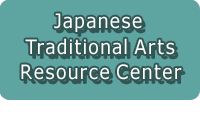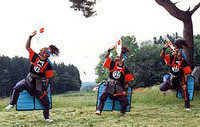

Total:35items
- Folk Performing Art (16)
- Kenbai: Sword Dance
- Kirin Shishimai: Kylin Lion Dance
- Yoshiwa Taiko Odori: Yoshiwa Drum Dance
- Omiya Odori: Omiya Dance
- Tsurusaki-Odori festival
- Omi Take-no-karakai (Tug-of-wars with bamboo)
- Nakizumo: Crying Baby Sumo
- Ryugasaki Tsukumai:Ryugasaki Acrobatic Performance
- Mikawa Manzai
- Esashi Oiwake: Esashi Folk Singing
- Ayado Yonenbutsu and Bon festival dance
- Occhi-no-Ohinagayu (rice porridge offering for the Doll's Festival in Occhi)
- Hanatori-odori Dance (Masuda area)
- Kaga-manzai
- Rice Planting festival of Tsutsukowake Shrine
- Edo sato kagura: Edo folk dance for entertaining god
- Kabuki (2)
- Noh & Kyogen (1)
- Festival (10)
- Ritual & Ceremony (2)
- Puppet Play (2)
- Folk technology (2)

 |
|
《Feature》
This folkloric dance is a sort of Nenbutsu-Odori (Nianfo folk dance: singing Buddhist chants while dancing with rolls of drums and gongs) and roughly categorized into 2 kinds: dances with or without masks. There are several similar dances such as Nenbutsu-Kenbai (Nianfo sword dance), Hinako-Kenbai (girls’ sword dance), Yoroi-Kenbai(armor sword dance), Dai-Nenbutsu(or Hon-Kenbai: Singing Buddhist chants loudly) etc.
There are different stories about the derivation of “Kenbai”, it could come from the wild dance with swords or the movement “Henbai”, in which people step firmly on the ground.
The dances are mainly dedicated to ancestors to comfort their spirits at the occasion of Ura-Bon, a Buddhist service in the middle of July. They have the meaning of driving away evil spirits, enlightenment of masses etc.
Oni-Kenbai (devil sword dance) is also a sort of Nenbutsu-Kenbai. It generally expresses the scene to lay ghosts called “Ikamono” wearing a rage mask by avatars of Buddha called “Saruko” or “Kakkata” (in some regions they wear clown or fox masks).
Hinako-Kenbai is characterized by gorgeous dances performed mainly by young girls and variations of drum rolls.
Hohnokizawa Nenbutsu Kenbai
In ancient times Nenbutsu Kenbai was performed in the region of Nishi-Iwai(southwest Iwate), then spread to Isawa, Esashi and Waga Regions to pray for laying evil spirits and driving enemies away, or remembrance of local ruling families, enlightenment of masses etc.
Especially, Hohnokizawa Nenbutsu Kenbai is said to inherit “Takadachi Mokke (ghosts in Takadachi)” which was created to comfort the spirits of Minamoto-no-Yoshitsune (a worrier in 12th century) and his attendants who went to their sorrowful end at Takadachi in Hiraizumi.
According to folk legend, “Takadachi Mokke” was only performed uniquely and secretly in Takadachi at the beginning, then in 1495, Daichiro, a performer of Takadachi Kenbai instructed the dance to 3 men in 3 different adjacent regions. In 1863, it was finally inherited by a man called Sogoro in Hohnokizawa. In general 8 dancers form one team, although there are exeptions such as the act “Ichiban-Niwa(The First Garden)” from Hon-Kenbai which has 13 dancers, one Kakkata(the Buddha avatar with monkey mask) and 2 girl/boy bookmakers. The story plays out as such: worrier ghosts go on a rampage then they get suppressed by Kakkata. In the old days the dance was performed as memorial services for the spirits in mid August. Today we see less such practices and the teams are invited more for Shrine rituals, various performing art events, as well as wedding ceremonies.
The year’s last dance is performed in October, which is called “Kasa-goshi(beyond
hat) ” event.
This folkloric dance is a sort of Nenbutsu-Odori (Nianfo folk dance: singing Buddhist chants while dancing with rolls of drums and gongs) and roughly categorized into 2 kinds: dances with or without masks. There are several similar dances such as Nenbutsu-Kenbai (Nianfo sword dance), Hinako-Kenbai (girls’ sword dance), Yoroi-Kenbai(armor sword dance), Dai-Nenbutsu(or Hon-Kenbai: Singing Buddhist chants loudly) etc.
There are different stories about the derivation of “Kenbai”, it could come from the wild dance with swords or the movement “Henbai”, in which people step firmly on the ground.
The dances are mainly dedicated to ancestors to comfort their spirits at the occasion of Ura-Bon, a Buddhist service in the middle of July. They have the meaning of driving away evil spirits, enlightenment of masses etc.
Oni-Kenbai (devil sword dance) is also a sort of Nenbutsu-Kenbai. It generally expresses the scene to lay ghosts called “Ikamono” wearing a rage mask by avatars of Buddha called “Saruko” or “Kakkata” (in some regions they wear clown or fox masks).
Hinako-Kenbai is characterized by gorgeous dances performed mainly by young girls and variations of drum rolls.
Hohnokizawa Nenbutsu Kenbai
In ancient times Nenbutsu Kenbai was performed in the region of Nishi-Iwai(southwest Iwate), then spread to Isawa, Esashi and Waga Regions to pray for laying evil spirits and driving enemies away, or remembrance of local ruling families, enlightenment of masses etc.
Especially, Hohnokizawa Nenbutsu Kenbai is said to inherit “Takadachi Mokke (ghosts in Takadachi)” which was created to comfort the spirits of Minamoto-no-Yoshitsune (a worrier in 12th century) and his attendants who went to their sorrowful end at Takadachi in Hiraizumi.
According to folk legend, “Takadachi Mokke” was only performed uniquely and secretly in Takadachi at the beginning, then in 1495, Daichiro, a performer of Takadachi Kenbai instructed the dance to 3 men in 3 different adjacent regions. In 1863, it was finally inherited by a man called Sogoro in Hohnokizawa. In general 8 dancers form one team, although there are exeptions such as the act “Ichiban-Niwa(The First Garden)” from Hon-Kenbai which has 13 dancers, one Kakkata(the Buddha avatar with monkey mask) and 2 girl/boy bookmakers. The story plays out as such: worrier ghosts go on a rampage then they get suppressed by Kakkata. In the old days the dance was performed as memorial services for the spirits in mid August. Today we see less such practices and the teams are invited more for Shrine rituals, various performing art events, as well as wedding ceremonies.
The year’s last dance is performed in October, which is called “Kasa-goshi(beyond
hat) ” event.
| City/Town | Oyama, Isawa Ward, Oshu City, Iwate Pref. |
|---|---|
| Location | Oyama, Isawa Ward, Oshu City, Iwate Pref. |
| Contact | Hohnokizawa Nenbutsu Kenbai Preservation Assoc. |
| Access | Mizusawa-Esashi Station, Tohoku Bullet Train |



